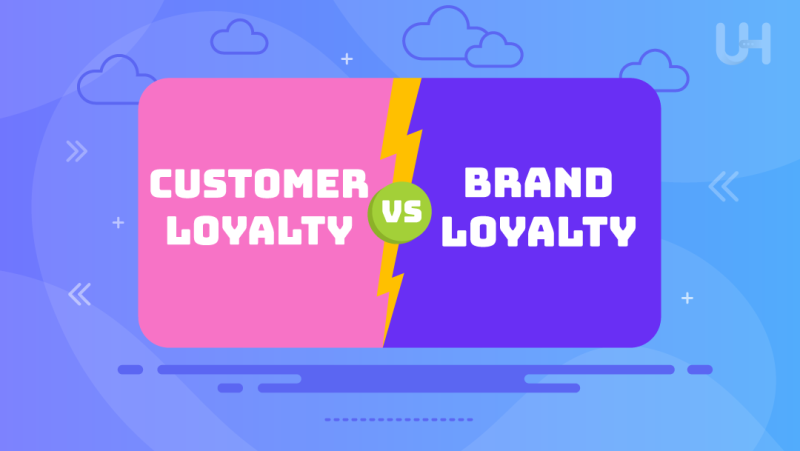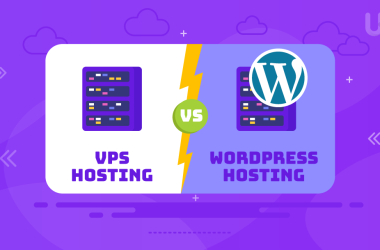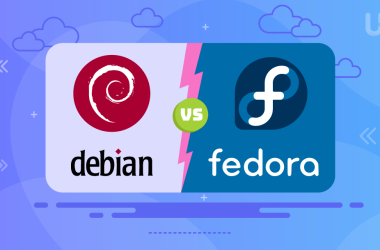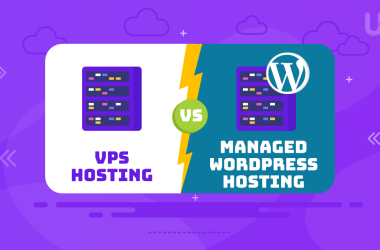Customer loyalty is the inclination of customers to consistently choose a specific brand’s products or services over others, leading to repeat purchases and positive word-of-mouth referrals. Brand loyalty, however, goes beyond transactions, involving an emotional connection based on shared values and trust, developing a deeper bond with the brand’s identity. Understanding the comparison of customer loyalty vs brand loyalty is important for businesses aiming to build sustainable success.
In this blog, we’ll talk about why people keep buying from the same company and why they feel connected to some brands.
Understanding Customer Loyalty
Customer loyalty refers to the tendency of customers to repeatedly choose a specific brand’s website, hosted on a fast server, over others in the market. It’s about building a strong connection between the customer and the brand, leading to repeat purchases and positive interactions.
Factors Influencing Customer Loyalty
- Quality of Products or Services: Customers are more likely to stay loyal to a brand when they consistently receive high-quality products or services that meet or exceed their expectations.
- Customer Service Experience: Exceptional customer service plays a crucial role in fostering loyalty. Exceptional customer service, often facilitated by efficient call center software plays a crucial role in fostering loyalty. When customers feel valued, heard, and supported, they’re more inclined to remain loyal to the brand.
- Pricing and Value Proposition: While price is important, customers also consider the overall value they receive from a brand. A competitive price combined with added benefits or unique offerings can enhance loyalty.
- Convenience and Accessibility: Brands that make it easy for customers to interact, purchase, and engage with them tend to inspire greater loyalty. This includes factors like user-friendly websites, convenient payment options, and accessible customer support channels integrated into an omnichannel support platform
Examples of Successful Customer Loyalty Strategies
- Loyalty Programs: Offering rewards, discounts, or exclusive perks to repeat customers encourages ongoing engagement and fosters a sense of appreciation.
- Personalization: Tailoring products, services, and communications to individual customer preferences and behaviors strengthens the bond between the customer and the brand.
- Community Engagement: Creating opportunities for customers to connect with each other and with the brand fosters a sense of belonging and loyalty.
- Feedback and Listening: Actively soliciting feedback and responding to customer concerns demonstrates a commitment to continuous improvement and builds trust.
Exploring Brand Loyalty
Brand loyalty goes beyond mere transactions; it’s about fostering a deep emotional connection and affinity between customers and a brand. Unlike customer loyalty, which focuses on repeat purchases, brand loyalty is characterized by a sense of loyalty and attachment to the brand itself, regardless of specific products or services.

Elements Shaping Brand Loyalty
- Brand Identity and Values: Brands that clearly define their identity and values resonate more strongly with consumers who share those values. When customers feel aligned with a brand’s purpose and mission, they’re more likely to remain loyal.
- Emotional Connections and Brand Affinity: Emotional connections play a significant role in brand loyalty. Brands that evoke positive emotions and make customers feel valued, understood, or inspired are better positioned to cultivate lasting loyalty. Ultimately, you can build a brand in your small business.
- Consistency in Brand Messaging: Consistency in branding across all touchpoints reinforces brand trust and reliability. When customers encounter consistent messaging, imagery, and experiences, it builds familiarity and reinforces their loyalty.
- Brand Reputation and Perceived Trustworthiness: A brand’s reputation for quality, reliability, and ethical behavior influences its perceived trustworthiness. Brands with a strong reputation are more likely to inspire confidence and loyalty among customers.
Cases Demonstrating Strong Brand Loyalty
- Apple: Apple’s brand loyalty is legendary, with customers often referring to themselves as “Apple fans” rather than just customers. The company’s focus on innovation, design excellence, and a seamless user experience has created a devoted following.
- Nike: Nike has built a powerful brand that transcends its products. Through its inspirational messaging, commitment to athletes, and cultural relevance, Nike has cultivated a loyal fan base that extends far beyond its athletic apparel and footwear.
- Starbucks: Starbucks has created a global community of loyal customers who see the brand as more than just a coffee shop. Its focus on creating a welcoming environment, personalized service, and ethical sourcing has fostered strong brand loyalty among coffee lovers worldwide.
Discover Perfect Hosting For Your Business!
Are you ready to take your business to the next level? Look no further! Unleash the power of seamless online shopping experiences, lightning-fast loading times, and unbeatable security.
The Relationship Between Brand Loyalty and Customer Loyalty
While customer loyalty and brand loyalty are closely related, they encompass distinct aspects of consumer behavior. Customer loyalty focuses on repeat purchases and preference for a particular brand’s products or services, while brand loyalty delves deeper into the emotional connection and affinity customers have with the brand itself.
How Does Customer Loyalty Influence Brand Loyalty and Vice Versa?
Customer loyalty and brand loyalty are intertwined in a symbiotic relationship. When customers consistently choose a brand’s products or services, it reinforces their affinity for the brand, strengthening brand loyalty. Conversely, a strong emotional connection with the brand can enhance customer loyalty by fostering repeat purchases and positive word-of-mouth referrals.
Strategies to Leverage Both Types of Loyalty Synergistically
Consistent Brand Experience: Providing a consistent and positive brand experience across all touchpoints reinforces both customer and brand loyalty. Consistency builds trust and reliability, encouraging repeat purchases and strengthening emotional connections with the brand.
Personalization: Tailoring products, services, and communications to individual customer preferences enhances both customer and brand loyalty. Personalized experiences make customers feel valued and understood, fostering a deeper connection with the brand.
Rewarding Loyalty: Implementing loyalty programs that offer rewards, discounts, or exclusive perks like photo canvas prints incentivizes repeat purchases and strengthens customer loyalty. By recognizing and rewarding loyal customers, brands can cultivate a sense of appreciation and foster brand loyalty.
Community Engagement: Creating opportunities for customers to engage with each other and with the brand builds a sense of belonging and strengthens brand loyalty. Community engagement initiatives, such as user-generated content campaigns or online forums, encourage customers to connect with the brand and each other, fostering a sense of loyalty.
Brand Loyalty vs Customer Loyalty: Assessing What Matters Most
Customer loyalty and brand loyalty each hold significance for businesses, but they operate on different levels. Customer loyalty is transactional, focusing on repeat purchases and favorable behaviors toward a specific brand. In contrast, brand loyalty is more holistic, involving emotional connections, shared values, and overall affinity for the brand itself. While customer loyalty drives short-term revenue, brand loyalty fosters long-term relationships and advocacy.
Impact on Business Performance and Long-Term Sustainability
Both types of loyalty have a profound impact on business performance and long-term sustainability. Customer loyalty contributes to revenue stability through repeat purchases and reduced customer acquisition costs. However, brand loyalty provides a competitive advantage by insulating the brand from market fluctuations and fostering customer advocacy, which generates positive word-of-mouth referrals and strengthens the brand’s reputation. Ultimately, brand loyalty contributes to greater resilience and sustainability in the face of market challenges.
Identifying Key Metrics for Customer Loyalty vs Brand Loyalty
Customer Loyalty Metrics:
- Measures the percentage of customers who make repeat purchases over a specific period.
- Indicates the percentage of customers who continue to patronize the brand over time.
- Assesses customer satisfaction and likelihood to recommend the brand to others.
Brand Loyalty Metrics:
- Measures the emotional connection and affinity customers have with the brand.
- Tracks the percentage of customers who actively recommend the brand to others.
- Assesses how customers perceive the brand in terms of trust, reliability, and alignment with their values.
Building a Comprehensive Loyalty Strategy
Building a comprehensive loyalty strategy requires a careful balance between short-term gains and long-term relationships, integrating both customer and brand loyalty objectives to create a robust framework for sustained success.
Integrating Customer and Brand Loyalty Objectives
To create a successful loyalty strategy, you need a reliable web hosting for your online audience. Then, it’s essential to integrate objectives that address both customer and brand loyalty. This means focusing on initiatives that not only drive repeat purchases and customer retention but also foster emotional connections and brand affinity. By aligning these objectives, businesses can cultivate a loyal customer base that not only continues to purchase but also becomes advocates for the brand.
Balancing Short-term Gains with Long-term Relationships
While it’s tempting to focus solely on short-term gains, a successful loyalty strategy must prioritize building long-term relationships with customers and building brand awareness. This involves going beyond transactional interactions to create meaningful experiences that resonate with customers on a deeper level. By investing in building trust, delivering exceptional customer service, and consistently exceeding expectations, businesses can lay the foundation for enduring loyalty that extends far beyond immediate sales.
Implementing Effective Loyalty Programs and Engagement Initiatives
Loyalty programs and engagement initiatives are valuable tools for unlocking new customers. However, their success depends on their relevance, value, and alignment with the brand’s objectives and customer preferences. Effective loyalty programs go beyond simple discounts or rewards; they provide personalized experiences, exclusive benefits, and opportunities for customers to engage with the brand on multiple levels. Whether through tiered rewards programs, VIP experiences, or community-building activities, businesses can leverage loyalty programs to strengthen relationships, drive repeat purchases, and enhance brand loyalty.
Customer Loyalty vs Brand Loyalty: Conclusion
To make sure a business does well, it needs to have a plan that combines both making customers happy and making them feel connected to the brand. This plan should balance getting short-term sales with building long-lasting relationships. Loyalty programs, like giving rewards or making customers feel special, can really help with this. So, remember, keeping customers happy and making them feel connected to the brand are key to making a business thrive.
As you take the next steps in expanding your business, consider partnering with a reliable hosting provider like Ultahost. Our WordPress for Enterprise is designed to empower your global ambitions, offering robust, secure, and scalable solutions to support your growth.
FAQ
What’s the difference between customer loyalty and brand loyalty?
Customer loyalty is when people keep buying from the same company, while brand loyalty is when people feel connected to and love a brand itself, not just its products.
Why is brand loyalty important?
Brand loyalty is important because it creates a strong emotional bond between customers and a brand, leading to repeat purchases, positive word-of-mouth, and long-term sustainability for the business.
How can businesses build brand loyalty?
Businesses can build brand loyalty by focusing on things like consistent branding, creating emotional connections with customers, delivering exceptional customer service, and offering unique value propositions that resonate with their target audience.
Are loyalty programs effective in building customer loyalty?
Yes, loyalty programs can be very effective in building customer loyalty if they offer meaningful rewards, personalized experiences, and opportunities for customers to engage with the brand on a deeper level.










